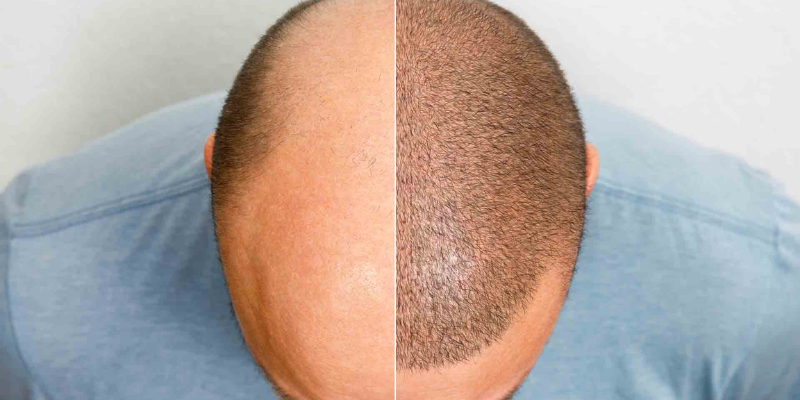How Long After Hair Transplant Exercise?
Hair transplant surgery is an easy and effective way to treat hair loss. But it is still a medical procedure with a critical recovery time when you need to be careful. So, pay extra attention to the weak parts of the head. This aftercare is important to protect your new, fragile hair transplants and your health as a whole. How long after hair transplant exercise? So, even though being active every day is good for you, you will need to put off some activities, like exercise, for a while after your surgery. You may want to get back to your normal life as soon as possible after FUT or FUE hair transplant surgery, but it’s important not to do anything that could hurt your healing. Even though exercise is good for our health in general, you should focus on getting better from your surgery right now.
Hair follicles are taken from the back of the scalp, which is called the donor area. The hair was then moved to places where hair loss had happened. Both FUE surgery and FUT surgery involve transplanting hair follicles from a donor area at the back of the scalp to areas where hair loss has happened.
How Long After Hair Transplant Can You Exercise?
After 2 weeks, you can work out again after a FUE hair transplant. In the first two weeks after your transplant, you shouldn’t sweat or strain. Both of these things happen when you exercise and can hurt your new grafts. After a hair transplant, patients can’t swim or play contact sports for 4 weeks.
If you are interested in getting a hair transplant but are also a fitness fanatic, there are some important things you need to know about your aftercare and recovery. In this guide, we’ll talk about how to exercise after a hair transplant. This will help you make better decisions after your procedure and get the most out of your hair transplant.
If working out is a regular part of your life, you may be eager to get back to it after your hair transplant surgery. But it is very important that you don’t do much exercise for the first 14 days after surgery.
Why Should You Avoid Exercising After Hair Transplant?
After the first 5 days after your hair transplant, you should try to take it easy and get as much rest as you can. If you find it hard to just sit back and relax, you can go for a walk. This shouldn’t hurt your transplant.
You might be surprised to find out that two weeks after surgery, you can often get back to your normal exercise routine. After a week, you can take small steps to add light exercise that doesn’t make you sweat back into your daily life.
When Can You Go Back To Workout After Hair Transplant?
For the first one to three days after your hair transplant, you shouldn’t do anything too strenuous, like work or walking around when you don’t have to. This is a very important time in your recovery, and you need to be very careful. Because swelling is more likely when there is more blood flow to the area, you shouldn’t lean down and should try to keep your head above the level of your heart. Try bending your knees instead of bending over to pick something up or tie your shoes. Also, don’t touch or do anything else to the sensitive area because this is a very important time for your grafts. After getting a hair transplant, exercise is a big risk for blood pressure problems. When the heart rate goes up, it’s easier for grafts to come loose, which can hurt the donor area and future implantations.
Most people can do light exercises like yoga or light walking 4 to 9 days after surgery. But if you want to keep your blood pressure from going up too much, you should avoid sweating, jogging, and aerobic exercise. If you feel more pain or swelling during this time, you should cut back on your workouts or stop for a few days. To keep the scalp from getting inflamed, everything you do should be gentle.
Swimming After Hair Transplant
You should avoid swimming and other activities that soak your hair because chlorine or salty water could hurt your grafts. Also, chlorine and other chemicals in swimming pools can hurt hair follicles and scalp skin by making them itchy and getting rid of the natural oils that protect them. You should also stay away from seawater and saltwater pools for the same reason: salt makes the skin dry and itchy. During the first few weeks after surgery, you should also avoid saunas and spas.
Experts usually say that you should wait at least a month before doing any water-based sports after a hair transplant. After that time has passed, they say to keep your hair moisturized and use a hair conditioner instead of washing it. This will protect your hair from harmful chemicals. Also, the amount of time it takes to recover from a hair transplant surgery varies from person to person. Situations like these may be different for each person. So, it makes it possible for you to get the results you want from your surgery.
Risks Of Exercising After Hair Transplant
You shouldn’t work out right after surgery to protect your new hair grafts, lower your risk of infection, and help your hair grow in a healthy way. Here are some things that could go wrong if you work out after a transplant:
Your hair transplant probably won’t change because you sweat. But after surgery, the scalp can be very sensitive, and sweating could make it worse. There is also a chance of getting an infection near the surgery site. The back of the neck can be stretched and strained by doing sit-ups and other exercises. This is especially dangerous if you’ve had FUT surgery because the scar on the donor site is still healing. The stitches could come loose and cause bleeding.
When you work out hard, your heart rate goes up, which in turn raises your blood pressure. Because there is more blood flowing to the scalp, it could swell and even bleed. People who play rugby or boxing are more likely to get a head injury than people who don’t. This can hurt hair follicles and make a hair transplant less likely to work.
How Important is Hair Transplantation After Care for Long-Term Results?
The hair transplantation is a standard and increasingly popular procedure that many men and women opt for to restore their natural hair. The procedure involves transferring healthy hair follicles from the back or sides of the scalp to balding areas. Although it is a relatively safe and straightforward procedure, take proper care of your hair after the surgery to ensure optimal results. The success of a hair transplant depends mainly on how well you take care of your scalp and newly transplanted hair follicles during the healing process. With proper hair transplantation after care, your hair may become smooth, firm, and even fall out. Here are some tips to help you maximize your hair transplant results and maintain your new look.

One of the most important steps in ensuring long-term success with a hair transplant is following your hair transplant surgeon ’s instructions for hair transplantation after care. Your doctor will likely provide you with detailed instructions for taking care of your scalp, including when and how often to wash it, as well as what products you should use. In addition, they may provide you with medications to reduce inflammation and help facilitate healing.





